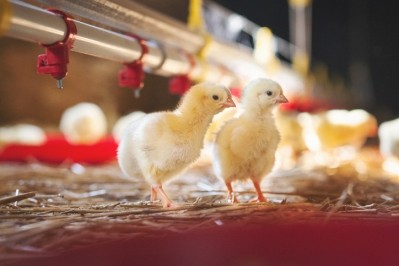Potential job losses as Cargill restructures its animal nutrition and feed business for continued growth

But there could be redundancies in the offing as well from the refit.
Cargill told us: “As a smart business looking to lay the foundation for some pretty strong growth, we are also looking for ways to run our business more efficiently and remove complexity from our system. So, as we execute our new operating model to serve our customers with world-class, innovative solutions and expert consultation, we’re also looking to ensure we’re running our business in the most cost-competitive way. As a result, we expect that, through this work, there will likely be a workforce impact.”
David Webster, the recently appointed president of the Cargill Animal Nutrition enterprise, gave us the low-down on the rationale for the restructuring.
To emphasize its increasing focus on health, he said Cargill has renamed the entire division Cargill Animal Nutrition and Health:
“This is an important move for us that not only [indicates] who we are today but where we are heading in the future. We have added the world ‘health’ to reflect the important work we have been doing in the specialty health ingredients area. Health is a key growth area for the whole of Cargill, not only in the animal space but in the human space also.”
“It is an important time for us to signal to the market that we are a different enterprise focused on expanded capabilities,” said Webster.
Its robust portfolio makes Cargill a global leader in feed and premix and in aqua nutrition but also in health ingredients, arising from its Diamond V acquisition, he said.
“Over the past couple of decades, via our people, our approach and our strategy, we have had phenomenal growth and success, both organically and through acquisitions. We want to continue that growth in the future, [and in order to do so], we are realigning our organization.”
New business groups
The realignment strategy sees Chuck Warta taking over as group leader of a new unit called Cargill Health Technologies. Warta previously ran the company’s premix and nutrition business; this new health technologies group comprises the company's Diamond V interests and its strategic investment in phytogenics producer, Delacon.
Adriano Marcon is now the group leader of Cargill Animal Nutrition, said Webster. Previously heading up the aqua feed business, Marcon will lead the animal nutrition business, which mergers the complete feed and the premix businesses.
Pilar Cruz has been named group leader of the “high-growth” Cargill Aqua Nutrition business. She was previously running the Cargill feed and nutrition business.
Prebiotic, probiotic and postbiotic capabilities
Cargill health technologies is a new group; it was previously embedded in the company’s premix and nutrition organization, he said. “We are standing the health technologies team up to focus more rigorously on innovation, creating products that push performance boundaries. We have some great products already in the market, and we continue to invest heavily in R&D for cutting edge technologies to help with animal immunity and health.”
With animal health and welfare being driving forces in the industry today, Cargill sees this unit “as key for prebiotic, probiotic and [the emerging area of] postbiotic capabilities.”
In terms of combining the feed and the premix side, he said Cargill is forming a powerhouse organization through such a merger. “This allows us to leverage the strengths of our two businesses and provide an integrated customer experience across both premix and feed,” continued Webster.
Cargill’s animal nutrition business’ origins are in the compound feed business, and it will remain a core element of the organization, he said.
“As we integrate the two businesses, we think about the feed customer as an absolutely critically important segment of the market that we want to continue to [develop] and focus on, and we have been experiencing growth in this space, organically and through M&A.”
Pilar Cruz, who is heading up the Cargill Aqua Nutrition unit, has over 20 years in leadership in Cargill across different areas of the company, both in the animal protein area as well as in the corporate business, strategy and development group. “She brings a very strong skill set and capabilities to allow us to continue to focus on the growth of our aqua nutrition business.”
Webster said that recent moves such as purchasing EWOS to building a state-of-the-art feed facility for shrimp in Ecuador as well as innovations around digital solutions and more traditional product development, together with partnerships like the tie-up with Innova Feed on insect protein and White Dog Labs on single cell protein give Cargill a remarkable foundation for growth in the aqua feed business.
“This is a significant shift for us. We see [the overall realignment of the animal nutrition business] as an opportunity for us to become more relevant for our customers, to push decision-making and innovation closer to customers, by placing some of our leadership out into regions globally.”
It is about ensuring Cargill, across all three animal nutrition business groups, stays agile, can act quickly and stay close to customers, while managing that regional and global dynamic, stressed Webster.
“We operate in 46 countries around the world, and we believe we have the industry’s best leading practitioners around nutrition and consultative approaches to help livestock [and fish] producers deal with difficult issues and solve problems.”
“Taking out roughly 50% of the pork production supply chain in China creates a huge hole for animal protein demand globally. That is unfortunate for producers in China, but it does, however, allow a lift in productivity and profitability for other producers globally, who have to fill that void.”
Signposting challenges and opportunities
Disease is having a much bigger impact on the animal protein and nutrition business than the tariff wars and trade disputes, he stressed.
Citing current industry challenges linked to disease such as African Swine Fever (ASF) spread in Asia, the subsequent herd culling, and the devastating impact on the animal protein supply chain, evidently in China, he, nevertheless, can see some positives in this respect:
“While very difficult for many producers in these affected countries, it also presents an opportunity to double down on sanitary conditions and health approaches. Standing up our health technologies business, it gives us [a chance] to demonstrate animal immunity in an even more robust and stronger way.
“Taking out roughly 50% of the pork production supply chain in China creates a huge hole for animal protein demand globally. That is unfortunate for producers in China, but it does, however, allow a lift in productivity and profitability for other producers globally, who have to fill that void.”
Hurdles also exist around consumer demands and expectations, particularly in relation to antibiotic usage and greater transparency in the supply chain. “As we develop our health business, we [look to] address antibiotic resistance and [to ensure] the use of antibiotics goes down over time.”
Moreover, the digital insights capabilities within Cargill, said Webster, will help provide some of that transparency in the supply chain that consumers are looking for.
When asked what he thinks of the likely impact of plant-based or cultured meat on the animal nutrition space, with Cargill itself backing developments in that sector - August 2019 saw it increase its exposure to pea protest, investing US $75m in Puris, which supplies plant-based burger producer, Beyond Meat - he said:
“Fundamentally Cargill is about consumer choice. It is a great opportunity for Cargill to participate in helping to feed 10 billion people. There is always going to be an important, significant role for animal protein production and meat consumption globally as we have urbanization occur, as standards of living increase, and as there is population growth. Alternative proteins and cultured meat will have a share of the market. That is good, it is good for consumers, for the industry, for competition, for getting us to think differently and making sure we stay on the cutting edge of technology to make our customers more robust and more efficient.”



















